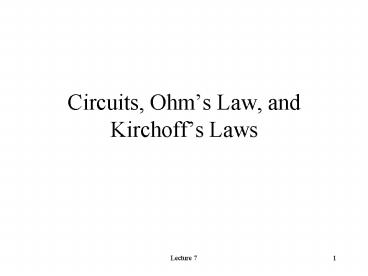Circuits, Ohm PowerPoint PPT Presentation
1 / 36
Title: Circuits, Ohm
1
Circuits, Ohms Law, and Kirchoffs Laws
2
Circuits
- A circuit is composed of elements (sources,
resistors, capacitors, inductors) and conductors
(wires). - Elements are lumped.
- Conductors are perfect.
3
Schematic
4
Schematic
- A schematic diagram is an electrical
representation of a circuit. - The location of a circuit element in a schematic
may have no relationship to its physical
location. - We can rearrange the schematic and have the same
circuit as long as the connections between
elements remain the same.
5
Nodes
- To find a node, start at a point in the circuit.
From this point, everywhere you can travel by
moving along perfect conductors is part of a
single node.
6
Example Find the Nodes
Vs
7
More Nodes
- Since the node is composed of perfect conductors,
the voltage (with respect to an appropriate
reference) anywhere in a node is the same.
8
Ohms Law
9
Resistors
- A resistor is a circuit element that dissipates
electrical energy (usually as heat). - Real-world devices that are modeled by resistors
incandescent light bulb, heating elements
(stoves, heaters, etc.), long wires - Parasitic resistances many resistors on circuit
diagrams model unwanted resistances in
transistors, motors, etc.
10
The Mathematical Model
- Resistance measured in Ohms (W)
- v(t) i(t) R - or - VIR
- p(t) i2(t) R v2(t)/R
11
Example the 25W Bulb
- If the voltage across a 25W bulb is 120V, what is
its resistance? - What is the current flowing through the 25W bulb?
12
Thought Question
- When I measured the resistance of a 25W bulb, I
got a value of about 40W. Whats wrong here?
13
Thought Answer
- The resistance of a wire increases as the
temperature increases. For tungsten, the
temperature coefficient of resistivity is
4.5x10-3/oK. A light bulb operates at about
5000oF.
14
Open Circuit
- What if R??
i(t)0
The Rest of the Circuit
v(t)
-
15
Short Circuit
- What if R0?
i(t)
The Rest of the Circuit
v(t)0
-
16
Kirchoffs Laws
17
Summary
- Kirchoffs Current Law (KCL) and Kirchoffs
Voltage Law (KVL) are fundamental properties of
circuits that make analysis possible.
18
Summary
- KCL
- sum of all currents entering a node is zero
- sum of currents entering node is equal to sum of
currents leaving node - KVL
- sum of voltages around any loop in a circuit is
zero
19
KCL Analogy
- Think of a node as being similar to an
intersection on a roadway. - The number of cars entering the intersection must
be equal to the number of cars leaving the
intersection or else cars will accumulate in the
intersection.
20
KCL Mathematically
i1(t)
i5(t)
i2(t)
i4(t)
i3(t)
- The sum of currents entering the node is zero
21
KCL-Christmas Lights
Is
50 1W Bulbs
22
To Solve for Is
- Find currents through each light bulb
- IB 1W/120V 8.3mA
- Apply KCL to the top node
- IS - 50IB 0
- Solve for IS
- IS 50 IB 417mA
23
KVL Analogy
- Applying KVL is analogous to taking a walk while
paying attention to increases and decreases in
altitude. If you walk in a loop (ie. you end
your walk where you started) the net change in
altitude is zero. This is true for any path that
you take for your walk.
24
KVL
-
v(t)2
v(t)1
v(t)3
-
-
- The sum of voltages around a loop is zero
25
Important Stuff
- A loop is any closed path through a circuit in
which no node is encountered more than once. - A voltage encountered to - is positive.
- A voltage encountered - to is negative.
26
Example-KVL around loop
- -V1 V2 V3 0
27
A Different Loop
a
V1
Vab
-
b
- -V1 Vab 0
- V1 Vab
28
More Stuff
- Loops need not include circuit elements.
- Arrows represent voltage differences they point
from low to high voltage.
29
What would happen if you forgot (or deliberately
ignored) the convention that to - is positive
and went around a loop using - to is positive?
30
KVL-Christmas Lights
-
VB
50 Bulbs Total
31
To Solve for VB
- Apply KVL around the loop
- 50VB - 120V 0
- Solve for VB
- VB 120V/50 2.4V
32
Example Thermal Noise
R
vs(t)
-
- R is a resistor in which charged particles
vibrate due to random thermal motion.
33
Equivalent Model
Rs
vs(t)
-
34
More on the Model
- RS is an ideal resistor (one in which there is no
noise). - vn(t) represents the thermal noise in the real
resistor.
35
Equivalent Voltage
Rs
vs(t)
-
vtot(t)
-
36
Solve for vtot(t) using KVL

